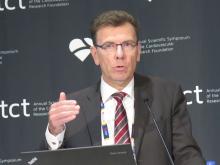SAN DIEGO – When it comes to preparing highly calcified coronary lesions for drug-eluting stents, rotational atherectomy has an early procedural advantage over modified balloons that cut or score the lesion, but yields similar clinical outcomes over time, according to results of the randomized PREPARE-CALC trial.
“Because severe calcification is mostly excluded from randomized PCI [percutaneous coronary intervention] trials, there is poor evidence for best PCI practice,” commented presenter Gert Richardt, MD, PhD, chief of cardiology and angiology at the Heart Center Segeberger Kliniken, Bad Segeberg, Germany. “Most interventional cardiologists will agree it is essential to facilitate stent delivery and adequate stent expansion in severely calcified lesions.”
Compared with standard balloon preparation, rotational atherectomy (rotablation) achieves a higher stenting success rate and better acute luminal gain, but its stimulatory effect leads to neointima formation that translates to late lumen loss, he noted. New balloons and drug-eluting stents may alter that calculus, however.
The 200 patients in PREPARE-CALC were randomized evenly to undergo preparation of their severely calcified coronary lesions with rotational atherectomy or a modified cutting/scoring balloon, each followed by placement of drug-eluting stents.
Compared with modified balloons, rotational atherectomy yielded a higher rate of successful stent delivery and expansion, according to data reported at the Transcatheter Cardiovascular Therapeutics annual meeting and simultaneously published online (Circ Cardiovasc Interv. 2018;11:e007415). The two methods did not differ significantly with respect to the 9-month magnitude of restenosis or rate of target vessel failure, at 6% with rotational atherectomy and 8% with modified balloons.
Importantly, about one in six patients in the modified balloon group had to cross over to rotational atherectomy because the balloon could not pass or sufficiently dilate the lesion.
“In patients with severely calcified coronary lesions, elective rotablation is feasible in nearly all patients, and the acute success rate is superior to modified balloons. Both approaches, elective rotational atherectomy and balloon plus bailout rotational atherectomy, are equally safe and effective,” Dr. Richardt summarized at the meeting sponsored by the Cardiovascular Research Foundation. “Use of rotablation is no longer associated with excessive late lumen loss in the era of modern drug-eluting stents.”
An underused tool
“This is a little bit ‘back to the future’ for me,” commented press conference panelist Mark Reisman, MD, director of the Center for Emerging Cardiovascular Therapies and head of UW Cardiology, Seattle. The PREPARE-CALC results are not surprising, but low uptake of rotablation in Europe, at just 1%-2%, is surprising and unexplained.
Importantly, the trial allows a sound comparison of rotational atherectomy with the best available alternatives, he said. “This may significantly impact the behavior and maybe some of the reimbursement in Europe. ... I’m sure that drives a lot of the decisions: cost as well as technique.”
Many of the original rotational atherectomy studies used larger burrs and multiple burrs, whereas the trial investigators applied less aggressive, more refined parameters. It will be interesting to look at their technique as it may have contributed to the favorable findings, according to Dr. Reisman.
“Based on what we just heard, there are very complex lesions that were maybe not being approached historically, which now people will feel a lot more confident in approaching, looking at the durable outcome with the Rotablator [Boston Scientific],” he summarized.
“From the practice of a clinician, it’s very frustrating to hit a calcified lesion and attempt to work on it up front and find you can’t cross it,” commented press conference panelist Morton J. Kern, MD, professor of medicine at the school of medicine and chief of medicine, VA Long Beach Health Care System, University of California, Irvine Medical Center. The high rate of crossover to rotablation in PREPARE-CALC speaks to this problem. Having to resort to this tool after failure of other lesional interventions often translates to a rockier overall procedure and clinical course.
“Lesion preparation is underestimated. I know from my own experience that [in] those calcified long lesions where I didn’t use the Rotablator, I regretted it in a fair number of cases,” Dr. Kern said. “So my view is that we probably don’t use it enough. This trial suggests that you can get away [without it], but I think ultimately, we are going to need this tool, even though it’s not used in a huge number of patients.”




